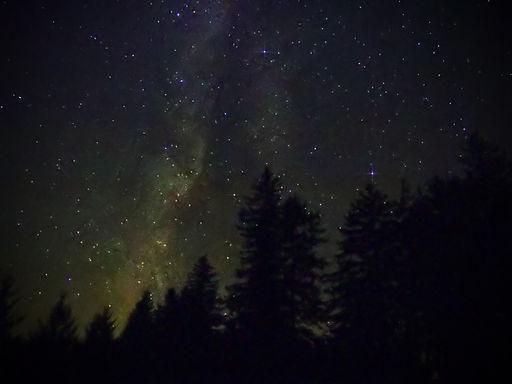THE SOLSTICE AND THE PLANETS by Dennis Herrmann
Early in June, three planets will line up in our west-northwest sky for us to see; but we will need to look during the first half of the month, for two of them will be in conjunction with the Sun and therefore invisible after June 16th.
On June 1st, Jupiter, Venus, and Mercury will form a straight line angling to the upper left from twilight’s glow at the horizon. The lowest, Jupiter, will be at –1.9 magnitude; the middle one and the brightest, Venus, will be at –3.9 magnitude; and the uppermost, Mercury, will be at –0.3. The constellation Gemini will be seen nearby, siting atop the trio and just to the left of Mercury, and will come into view as twilight fades and the sky darkens more. The three planets will span about 9 degrees of space, from Jupiter, up and left to Mercury, which is about as much sky space that one can cover with a clenched fist held out at arm’s length. Jupiter will be invisible to us by June 15th, but Venus will appear to gain altitude slowly all month as its orbit takes it around the Sun. On June 25th Venus will form a straight line with Gemini’s two brightest and uppermost stars, Castor and Pollux. Meanwhile Mercury will appear to gain altitude for a few more days, reaching its peak on June 12th, when it will be 12 degrees above the horizon, 40 to 75 minutes after sunset. On June 10th a slim crescent Moon may be seen just 6 degrees to the lower left of Mercury. This will help direct one in spotting the innermost planet in our Solar System.
Summer Solstice occurs on June 21st this year; at precisely 1:00 pm. EDT. This places the Sun at its highest point above the horizon for all northern hemisphere skywatchers, which for us will put the Sun at 73 1/2 degrees above the southern horizon at noon. This marks the official start of summer.
As the sky darkens in June, Saturn is the other planet that can be seen, nearly halfway between the southern horizon and the zenith. It is nestled among the stars of zodiac constellation Virgo all summer. Saturn makes a great sight — a real treat to the eye —— for those skywatchers who can look at it through a telescope. Its beautiful rings are without rival, but decent sized scopes will reveal several of Saturn’s multiple moons.
Coming up now in summer’s first month in the northeast sky is the asterism known popularly as the Summer Triangle. It consists of three first magnitude stars, that can be connected in a triangle, each one found in a separate constellation. The brightest and highest up is VEGA, in the tiny constellation shaped like a parallelogram, called Lyra the harp. Below and left of Vega is Deneb in Cygnus the swan, and then below and under Cygnus, we can see Altair, in Aquila the eagle. During the summer months this bright asterism will ride up and high up near the zenith, and them descend in late summer and all through the fall toward the northwest horizon. Indeed, the Summer Triangle can still be seen low in the northwest sky in the weeks just before Christmas!
After a New Moon on June 8th, 1st quarter will be on the 16th; Full Moon on the 23rd, and Last quarter on June 30th.



Write a Letter to the Editor on this Article
We encourage readers to offer their point of view on this article by submitting the following form. Editing is sometimes necessary and is done at the discretion of the editorial staff.